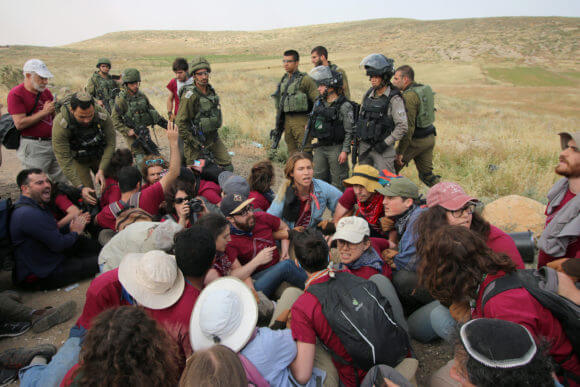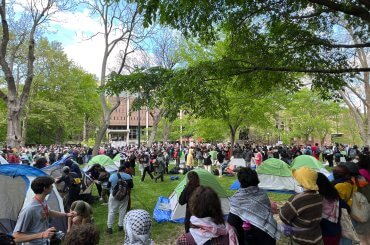When is a road more than a road? Last week, Canadian Rabbi David Mivasair was arrested, along with ten other North American Jews, two Palestinian journalists, and two Palestinian locals, for the crime of trying to repair a critical access road connecting five rural Palestinian communities in the Southern West Bank. Typical of Israel’s ‘slow violence’ strategy in Area C, the access road has been made to degrade to the point that the villages can only supply themselves with the basic essentials of life at great expense and with extreme difficulty (i.e. hiring tractors to haul in water). The degraded roads, along with the ever present threat of settler violence on them, isolate the villages from one another, making the ordinary circulations of daily life – visiting, going to school, sharing a meal – extremely difficult. Upon his release from what he called “a gigantic fortress of a police station on top of hill in Hebron,” Rabbi Mivasair remarked on another separation at the heart of the occupation: “They released me on the ‘Jewish’ side. They released the Palestinians on the ‘Palestinian’ side….Apartheid goes all the way to where they release people after prison.”
SHOCKING footage coming out from yesterday as @CJNVtweets delegate and @IfNotNowOrg organizer, @bloomekatz is punched by an Israeli solider. For what? Rehabilitating a critical access road for Palestinians. pic.twitter.com/9OgpZweUAL
— All That's Left: Anti-Occupation Collective (@ATLCol) May 4, 2019
American Ari Bloomekatz, also arrested in the road repair action, experienced a more disturbing, yet equally common strategy used by Israeli forces to separate and degrade relations between Israeli and international Jews and Palestinians: the use of different degrees of physical violence. His own arrest was violent. There is shocking footage of him being slammed in the face and knocked backward by the force of a blow from a heavily armed, masked IDF soldier. In detention he and other international Jews were made to witness the brutal beating of a young Palestinian man: “We watched as the boy was grabbed, choked, beaten, and had his back bent painfully by Israeli soldiers, all in broad daylight. He begged for them to stop. It was horrifying.” Did Bloomekatz and the other North American Jews witness this violence incidentally, because the soldiers presumed their own impunity? Or was the spectacle meant to amplify the trauma for all of them, Jewish and Palestinian, to deny or denigrate their embodied care for one another, made visible in their coordinated resistance?
Road repair done as direct action against the occupation and its cruel logistics makes a good symbol for the infrastructures of steadfastness being built between North American Jews, Southern West Bank Palestinians, and the Israeli left. These growing relationships of friendship, understanding and co-resistance form an important counterpoint to the oppressive imaginaries of Trump and Netanyahu (which assign symbolic non-existence to Palestinians) and to the psychic alienation of mainstream North American and Israeli Jews (predisposed not to see the oppressive realities of Palestinian lives).
These growing infrastructures of steadfastness (sumud) are being built at two speeds of relationship-making: the slow time of everyday hospitality and the fast time of civil disobedience actions. We catch a glimpse of this in the press release’s description of the action as the outcome of groundbreaking partnerships between the Center for Jewish Nonviolence (with more than 50 North American participants, half veterans of previous actions), All That’s Left (Israeli Jewish resisters), and a remarkable and thriving alliance of Palestinian village councils, grassroots groups, and activists (Masafer Yatta Council, Susiya Village Council, A-Tuwani Village Council, Youth of Sumud, Sumud Protection Committee, the Good Shepherd Assocition, Rural Women’s Association of the South Hebron Hills, and activists from the South Hebron Hills communities of Susiya, Umm al-Khair, Sarura, Tuba, and A-Tuwani).
Having participated in a direct action with the Center for Jewish Nonviolence and several of the village councils in 2017, when we reclaimed the lands and cave home of a dispossessed family in Sarura, I have witnessed how the two speeds of relationship-building work. In terms of the time of everyday hospitality, Palestinian locals host international and Israeli Jews as guests in their home villages in Area C, villages often sandwiched between illegal settlements and outposts, under demolition orders, and experiencing everyday settler violence and the hardships of enforced underdevelopment. Many of the international and Israeli Jews speak Arabic; several of the Palestinian activists have studied English at the university level, so deep, hopeful preparatory work has been done in advance to overcome language barriers. Through a rhythm of ‘work days’ of rebuilding demolished structures, planting, gardening, rehabilitating, and sharing stories, and ‘visiting nights’ of cooking, building fires, drinking tea, sharing more stories, and sleeping over in tents, caves, homes, and community centers, everyday understandings shift and fortitude develops with growing closeness. In the words of Karen Isaacs of All That’s Left, “Getting to know this region over the past six years transformed my understanding of the reality of occupation, and the inspiring and committed local activists transformed my understanding of what is possible…This region has a long history of joint non-violent struggle against the occupation and I know that if we all bring our own communities to work together for the rights of all people, we can win.”
From earlier: singing olam chesed while trying to protect one of our partners. #coresist pic.twitter.com/dDExXbIt7e
— All That's Left: Anti-Occupation Collective (@ATLCol) May 3, 2019
In terms of the fast time of civil disobedience, when Jewish bodies resist with Palestinian bodies under Palestinian leadership in the occupied Palestinian territories, a thick relationality develops quickly despite the differential risks. This relationality forms as bodies move together in the shape of singing, chanting, holding hands, arms, clothing, clumping together to prevent the police and military from pulling people out to violate them as individuals, Palestinians especially. It portends and performs a care for each other and for being a collective together which upends the alienations and and partitions of Occupation. In this case, after thirty minutes of road repair, the IDF declared a closed military zone and threw tear gas and sound grenades at the group, whose direct action was merely to sit down and refuse to leave the road. When the IDF made arrests, North American and Israeli Jewish participants in the direct action, pulled their Palestinian partners into the middle of their group, to shield them as much as possible from arrest and separation. (“We got you, Tariq,” one young woman says in a cell phone video of the action.) Whenever the police began to drag people away, others would embrace them tightly, sit down or lie over them, to bundle together their weight and passive resistance. Such collective action forms infrastructures of steadfastness (and love) that expand who we think ‘we’ are and stretch towards a post-occupation future of everyday okayness that no longer feels counter-intuitive.
How can we scale up these infrastructures of steadfastness? The Boycott, Divest, Sanctions (BDS) movement presents an opportunity because it is relationship-building on a large scale, yet has to be supplemented with on-the-ground, thick human relationships to truly become a liberatory social movement. As Israeli scholar Eyal Weizman puts it, during boycotts “you have to build relationships at the same time as you withdraw from other relationships.” Unfortunately, in the North American context BDS work too often prioritizes defending BDS as a strategy over building reciprocity, intimacy, and relationality with Palestinians in the West Bank, Gaza, and the diaspora. In the words of Awdah Al-Hathalean of the Good Shepherd Collective, speaking to North American Jews organized by CJNV, “Solidarity is not enough; the most important thing is for you to come visit, and come back again.” Annexation or not, during and after the Trump-Netanyahu alliance, we need to build and hold more infrastructures of steadfastness that simultaneously disrupt the logistics of occupation and strengthen circulations of imagination, resources, and relationships for liberatory world-making together across North America and Israel/Palestine.


